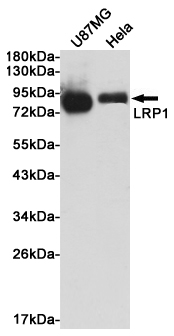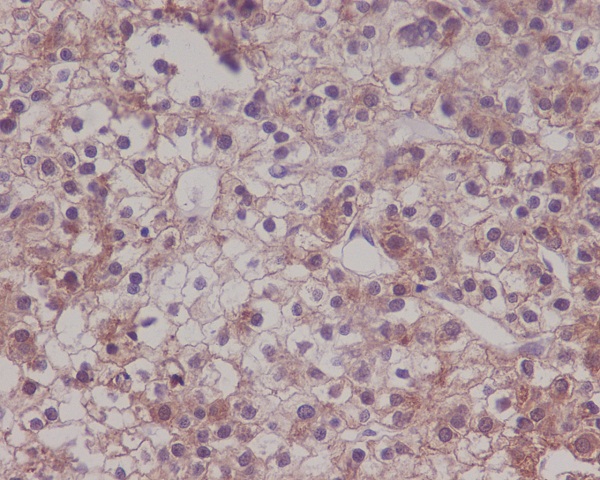

| WB | 咨询技术 | Human,Mouse,Rat |
| IF | 1/20 | Human,Mouse,Rat |
| IHC | 1/50-1/100 | Human,Mouse,Rat |
| ICC | 1/50-1/200 | Human,Mouse,Rat |
| FCM | 1/50-1/100 | Human,Mouse,Rat |
| Elisa | 咨询技术 | Human,Mouse,Rat |
| Aliases | A2MR; alpha 2MR; Alpha 2 macroglobulin receptor; CD91; APR; LRP1; LRP85; TGFBR5 |
| Entrez GeneID | 4035 |
| WB Predicted band size | Calculated MW: 505 kDa; Observed MW: 85 kDa |
| Host/Isotype | Rabbit IgG |
| Antibody Type | Primary antibody |
| Storage | Store at 4°C short term. Aliquot and store at -20°C long term. Avoid freeze/thaw cycles. |
| Species Reactivity | Human,Mouse,Rat |
| Immunogen | A synthesized peptide derived from human LRP1 |
| Formulation | Purified antibody in PBS with 0.05% sodium azide. |
+ +
以下是关于LRP1抗体的3篇参考文献,包含文献名称、作者及摘要内容概括:
---
1. **文献名称**:*LRP1 modulates APP trafficking along early compartments of the secretory pathway*
**作者**:May P, Bock HH, Nimpf J, et al.
**摘要**:该研究利用抗LRP1抗体(如小鼠单抗克隆5A6)验证LRP1与淀粉样前体蛋白(APP)的相互作用,发现LRP1通过调控APP在高尔基体等分泌途径中的运输,影响β-淀粉样蛋白(Aβ)的生成,为阿尔茨海默病机制提供新见解。
---
2. **文献名称**:*Clearance of Alzheimer’s amyloid-β by the low-density lipoprotein receptor-related protein 1*
**作者**:Shibata M, Yamada S, Kumar SR, et al.
**摘要**:通过免疫共沉淀和抗体阻断实验(如抗LRP1抗体R2629),证明LRP1介导血脑屏障对Aβ的清除作用,LRP1功能缺陷可能导致Aβ在脑内沉积,与阿尔茨海默病病理相关。
---
3. **文献名称**:*LRP1 promotes cancer cell invasion by supporting ERK and inhibiting JNK signaling pathways in tumor-associated macrophages*
**作者**:Nguyen DHD, Catheline D, Charrier-Hisamuddin L, et al.
**摘要**:研究采用抗LRP1抗体(兔多抗)进行免疫组化分析,发现肿瘤相关巨噬细胞中LRP1通过调节ERK/JNK信号通路促进癌细胞侵袭,提示其作为癌症治疗的潜在靶点。
---
这些文献涵盖了LRP1抗体在神经退行性疾病和肿瘤研究中的应用,实验方法包括Western blot、免疫沉淀及免疫组化等。
LRP1 (low-density lipoprotein receptor-related protein 1), also known as CD91 or α2-macroglobulin receptor, is a multifunctional cell surface receptor belonging to the LDL receptor family. It plays critical roles in endocytosis, cellular signaling, lipid metabolism, and clearance of proteinaceous waste, including amyloid-β in the brain. Structurally, LRP1 consists of a 515 kDa extracellular α-chain and an 85 kDa transmembrane β-chain linked by disulfide bonds. It interacts with over 40 ligands, including apolipoprotein E (ApoE), α2-macroglobulin, and tissue-type plasminogen activator, mediating their uptake or modulating downstream pathways like MAPK and PI3K/AKT.
LRP1 antibodies are essential tools for studying its expression, localization, and function in physiological and pathological contexts. They are widely used in techniques such as Western blotting, immunohistochemistry, and flow cytometry to investigate LRP1's involvement in diseases like Alzheimer's disease (impaired amyloid-β clearance), cancer (dual roles in tumor suppression/progression), and atherosclerosis (lipid regulation). Some antibodies target specific domains to block ligand binding or receptor dimerization, aiding in mechanistic studies. Therapeutic applications are emerging, including antibody-drug conjugates for targeted cancer therapy and strategies to enhance LRP1-mediated amyloid-β clearance in neurodegenerative disorders. Validation of LRP1 antibodies remains crucial due to its structural complexity and splice variants.
×